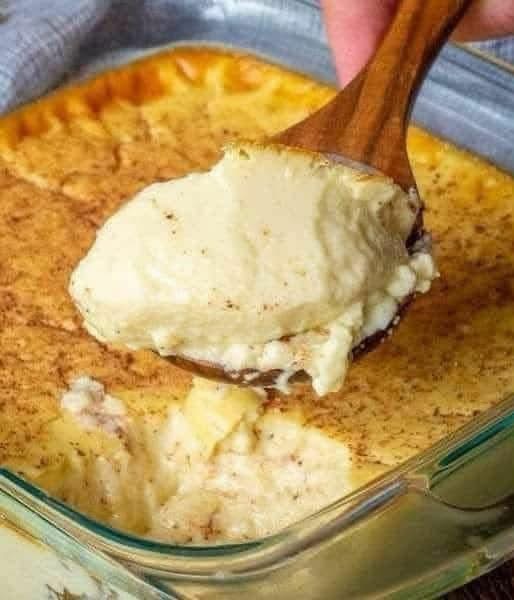Of course! Amish Baked Custard is a classic, humble dessert that is incredibly comforting and simple to make. It’s known for its smooth, silky texture and delicate, sweet flavor. Unlike many modern custards, it often contains no vanilla, letting the pure flavor of the eggs, milk, and sugar shine through.
Here is a traditional recipe that will guide you to perfect, jiggle-free custard every time.
Amish Baked Custard
This recipe yields a rich, creamy, and perfectly set custard that is baked in a water bath for gentle, even cooking.
Yields: 4-6 servings
Prep time: 10 minutes
Cook time: 60-75 minutes
Cooling time: 2 hours
Ingredients:
· 4 large eggs
· ½ cup (100g) granulated sugar
· ¼ teaspoon salt
· 4 cups (1 quart / 950ml) whole milk, warmed
· 1 teaspoon vanilla extract (optional, but common in modern versions)
· Ground nutmeg, for sprinkling
Instructions:
Step 1: Prepare for Baking
- Preheat Oven: Preheat your oven to 325°F (160°C).
- Prepare Water Bath: Bring a kettle or pot of water to a boil. You will need enough hot water to come halfway up the sides of your custard cups or baking dish.
- Prepare Dish: Lightly grease a 1.5-quart ceramic or glass baking dish, or 6 individual (6 oz) ramekins. Place the dish(es) inside a larger roasting pan.
Step 2: Make the Custard Base
- Whisk Eggs, Sugar, and Salt: In a large bowl, whisk the eggs, sugar, and salt together until just combined and the sugar is dissolved. Do not whisk vigorously to the point of creating lots of foam; you want a smooth, homogenous mixture.
- Temper with Warm Milk: Gently warm the milk in a saucepan or the microwave until it is just hot to the touch but not boiling (this helps the custard bake more evenly). Slowly pour the warm milk into the egg mixture while whisking constantly. This gradual process, called tempering, prevents the eggs from scrambling.
- Add Vanilla (Optional): If using, stir in the vanilla extract.
- Strain (Highly Recommended): For the absolute silkiest texture, strain the custard mixture through a fine-mesh sieve into a large pouring jug or bowl. This catches any bits of coagulated egg.
Step 3: Bake in a Water Bath
- Pour Custard: Pour the strained custard into the prepared baking dish(es). Sprinkle the top generously with ground nutmeg.
- Create the Water Bath: Carefully place the roasting pan with the custard dish(es) onto the middle oven rack. Then, carefully pour the hot water from the kettle into the roasting pan until it comes about halfway up the sides of the custard dish(es).
- Bake: Bake for 55 to 75 minutes for a large dish, or 45 to 55 minutes for individual ramekins. The custard is done when the edges are fully set, but the center still has a slight “jiggle” when you gently shake the pan. A knife inserted near the center should come out clean.
- Avoid Overbaking: Overbaking will cause the custard to become watery (it “weeps”) and lose its smooth texture.
Step 4: Cool and Serve
- Careful Removal: Using oven mitts, carefully remove the entire roasting pan from the oven. Lift the custard dish(es) out of the hot water bath and place them on a wire rack.
- Cool Completely: Let the custard cool to room temperature. Then, cover with plastic wrap and refrigerate for at least 2 hours, or until thoroughly chilled.
Serving Suggestions
· Serve the custard chilled, straight from the dish or ramekin.
· It’s perfect on its own, but a fresh berry compote, a dollop of whipped cream, or a few fresh berries make a lovely accompaniment.
Chef’s Tips for Perfect Custard
· The Water Bath is Non-Negotiable: This gentle, indirect heat is the secret to a smooth, creamy custard without bubbles or curdling.
· Don’t Whisk Too Much: Over-whipping incorporates too much air, which can lead to a foamy, porous texture.
· Straining is Key: This simple step ensures any small bits of egg or undissolved sugar are removed, guaranteeing a velvety final product.
· The Jiggle Test: Trust the jiggle more than the clock. Oven temperatures can vary. The center should move as one mass, not look liquidy.
· Scalding the Milk: Warming the milk isn’t just for tradition; it helps the sugar dissolve and shortens the baking time, reducing the risk of the eggs curdling.
Enjoy this simple, comforting, and timeless dessert straight from the Amish kitchen
